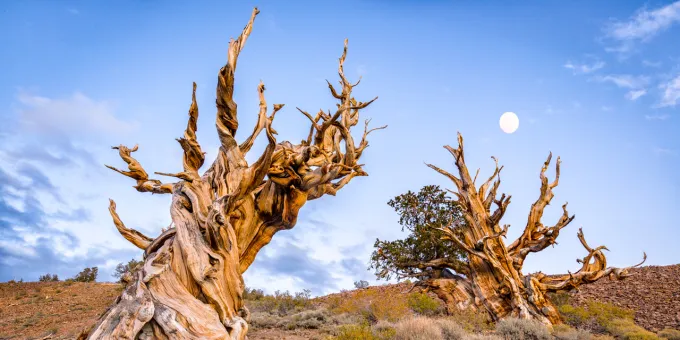California is the most biodiverse state in the union, thanks to its vast size and its unique climate, geography, and geologic history. Covering more than 160,000 square miles, its breathtaking landscape is a wondrous tapestry of mountains, valleys, forests, deserts, and coastline. These habitats play host to a wealth of natural wonders, from the state’s iconic palm trees to some of the world’s most spectacular wildflower blooms.
Three guests—Dr. Emily Lindsey, assistant curator and excavation site director at La Brea Tar Pits and Museum in Los Angeles; Jason Dewees, author of Designing with Palms and a horticulturalist at Flora Grubb Gardens in San Francisco; and Obi Kaufmann, author and illustrator of The California Field Atlas—shared their favorite destinations for appreciating California’s biodiversity on the latest episode of the California Now Podcast.
“The real California gold, if you will, is our biodiversity—our natural world,” Kauffman tells host Soterios Johnson. “We have such a wealth of accessibility to natural landscapes and it's all still here. As you get to know these places, you can't help but fall in love.”
Here are picks from Kaufmann, Lindsey, and Dewees for the best places across the state to experience and celebrate California’s natural wonders.
Ancient Animals
California has been a hotbed of biodiversity since prehistoric times, and there’s no better place to get a glimpse of the amazing creatures that once roamed the state than at La Brea Tar Pits in the heart of Los Angeles. It was there, during the last 50,000 years, that a menagerie of large mammals perished in La Brea’s sticky asphalt pools. The result is one of the world’s best-preserved collections of fossilized vertebrates.
“Our most common [fossil] is the dire wolf,” Lindsey says. “A lot of people think dire wolves are just something that existed in Game of Thrones, but they were real animals. And La Brea Tar Pits is far and away the most famous place to study them. We also have many, many remains of things like mammoths, mastodons, giant ground sloths, American lions, camels, horses, bison, just an incredible array of large mammals that you think of when you think of the Ice Age.”
While the indoor museum is currently closed due to pandemic restrictions, visitors can marvel at La Brea’s active asphalt seeps in the surrounding park, and watch museum paleontologists digging up fossils trapped tens of thousands of years ago.
Pines and Palms
With thousands of both native and transplanted species dotting the state’s diverse landscape, California is a tree lover’s paradise.
Drive up Interstate 5 in the state’s northwest corner and you’ll arrive in Scott Valley and the Marble Mountain Wilderness area. Among the 225,000-acre site’s craggy peaks and canyons you’ll encounter deciduous oaks, blooming California dogwood trees, and a unique conifer called the weeping spruce.
“It’s one of these places where every several hundred yards you drive up the mountain, the environment changes,” Dewees explains. “And then you get up to the top of the pass and you can hike out into glacially carved valleys with beautiful cold lakes and meadows full of wild flowers. It's one of the most accessible and beautiful places to see a unique California landscape—and botanically it’s one of the richest places in the United States.”
Mono Lake, just east of Yosemite National Park in Mono County, is an ancient saline lake that supports a unique ecosystem. It contains no fish, yet is filled with trillions of brine shrimp and alkali flies that support millions of migratory birds that visit the lake each year.
About 90 miles southeast is Inyo National Forest, home to the world’s oldest trees: bristlecone pines. Showing off spectacularly twisted trunks, some specimens in the Ancient Bristlecone Pine Forest are more than 4,000 years old.
Palm trees are California icons too, and the Greater Palm Springs area is one of the best places to see them. At Thousand Palms Oasis in the Coachella Valley Preserve, hundreds of palm trees grow in a marshy area surrounding a beautiful pond. The site looks like the kind of oasis you’d see in Hollywood movie—except this one is natural. Also near Palm Springs is Indian Canyons, which boasts spectacular groves of desert fan palms.
Wild About Flowers
Each spring, a parade of wildflowers blooms its way across California over a six-month span. Known as the vernal bloom, it begins in the state’s southern desert areas in February, then works its way north. In July or August, the bloom displays a gorgeous finale in Siskiyou County near the Oregon border.
Some of the most spectacular desert spots include Anza-Borrego Desert State Park in the Sonoran Desert, the Mojave National Preserve, and Death Valley, which is carpeted with flowers for several weeks each year in early spring.
Wall-to-wall spring wildflowers aren’t the only attraction at Carrizo Plain National Monument in San Luis Obispo County. The site is also an incredible place to spot hundreds of species of migrating birds, along with kangaroo rats, kit foxes, and the occasional pronghorn antelope.
Mid-April is the time to see wildflowers at Mount Diablo State Park in the Tri-Valley area. The wind carries seeds there from both the northwest and the desert, so you’ll find rainforest and desert flowers growing side by side.
Later in the season, mountain blooms thrive in the Crystal Range west of Lake Tahoe. At sunset, red light passing through the ridgeline’s granite quartz creates a prismatic effect that makes the flowers appear even more beautiful.
